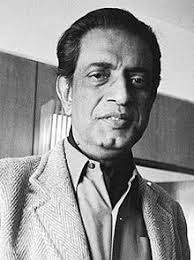Satyajit Ray (1921-1992)
Satyajit Ray (1921-1992) was a renowned
Indian filmmaker, screenwriter, author, and music composer. He is considered to be one of the greatest filmmakers of all time and is credited with bringing Indian cinema to international recognition. Ray's films were known for their realism, aesthetic quality, and focus on social issues. Ray was also a prolific writer and illustrator, and his literary works and illustrations have garnered widespread acclaim.Early Life and Education:
Satyajit Ray was born on May 2, 1921, in Calcutta (now Kolkata), West Bengal, India. He was the youngest of the four children of Sukumar Ray, a prominent Bengali writer, and illustrator, and Suprabha Ray, a social worker. Ray grew up in an intellectually stimulating environment and was exposed to literature, art, and music from a young age. He attended Ballygunge Government High School and graduated with distinction in English from Presidency College, Calcutta.
Career:
After graduating from college, Ray worked as a graphic designer and illustrator for various advertising agencies. He was also involved in film societies and started writing film criticism. Ray's interest in filmmaking was sparked when he met the French filmmaker Jean Renoir, who was shooting a film in Calcutta. Ray assisted Renoir during the filming of 'The River' (1951) and learned the craft of filmmaking from him.
Ray's first film, 'Pather Panchali' (1955), was based on a novel by Bibhutibhushan Bandopadhyay and portrayed the life of a poor Bengali family. The film was made on a low budget with a non-professional cast and crew and took three years to complete. The film was screened at the Cannes Film Festival in 1956 and won several international awards. It was a critical and commercial success and established Ray as a major filmmaker.
Ray went on to make several other critically acclaimed films, including 'Aparajito' (1956), the second film in the 'Apu Trilogy', which won the Golden Lion at the Venice Film Festival; 'Charulata' (1964), a period drama about a lonely housewife, which won the Silver Bear at the Berlin Film Festival; and 'Shatranj Ke Khilari' (1977), a historical drama set during the British Raj, which won the National Film Award for Best Feature Film.
In addition to filmmaking, Ray was also a prolific writer and illustrator. He wrote several books, including the Feluda series of detective novels, and illustrated many of his own works. His illustrations were characterized by their simplicity, elegance, and humor.
Ray's Contributions to Indian Cinema:
Ray's contributions to Indian cinema were immense. He is credited with introducing a new style of filmmaking that focused on realism and social issues. His films portrayed the lives of ordinary people and their struggles, and dealt with themes such as poverty, oppression, and social inequality. Ray's films were also noted for their aesthetic quality, with an emphasis on natural light, long takes, and non-professional actors.
Ray's films were not only critically acclaimed but also had a profound impact on Indian cinema. He inspired a generation of filmmakers and his work paved the way for the New Wave movement in Indian cinema. Ray's influence can be seen in the works of contemporary Indian filmmakers such as Mira Nair, Deepa Mehta, and Anurag Kashyap.
Awards and Honors:
Ray's contribution to Indian cinema was recognized with several national and international awards. He received the Padma Shri in 1958 and the Padma Bhushan in 1965. In 1984, he was awarded the prestigious Bharat Ratna, India.















No comments